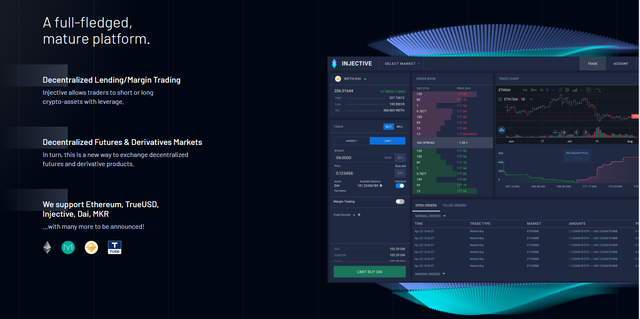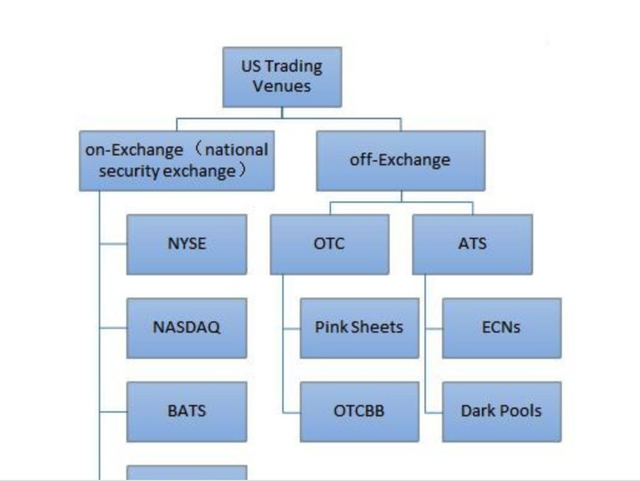.png)
Injective chain is based on the Cosmos zone and is a decentralized protocol built on Layer-2, providing a high-speed Ethereum decentralized trading experience. It will use the Cosmos IBC protocol to achieve cross-chain transactions, VDF (Verifiable Delay Function) to simulate real-time through Proof of Elapsed Time, and standardize order sequencing to eliminate early tradings. Also, the Injective chain supports token staking and provides technical support for creating more services such as staking in the future.
A derivatives protocol is an important "weapon" of Injective. It is an open protocol that supports the development of open derivatives markets. It is also the world's first fully decentralized P2P futures and perpetual swap contracts exchange, which supports simple access to various markets. According to the team, compared with other products of the same type, Injective is the fastest, fully decentralized derivatives trading platform without gas fees in the Defi market.
Based on the Injective chain, Injective's trading platform has also achieved a fully open-source design, which allows it to be a completely decentralized network. It also provides a market-maker friendly API interface, which is close to the current mainstream exchange interface, allowing the user experience to be similar to that of a centralized exchange. Additionally, in the management system, the Injective trading platform has borrowed the design from the auditing systems of centralized exchanges, modularized design, and the audited listing system, but it is based on community management, not just one person. Also, Injective has introduced liquidity support for DEX from a considerable number of top global market makers, including QCP, CMS, Bitlink, Altonomy, etc. Together with a powerful incentive mechanism, Injective can ensure the liquidity of the trading platform.
The future is coming, and the exchange, as the infrastructure of the digital age, is undergoing rapid and unprecedented development. In 2020, we will witness this change.
Internet finance and the digital age

Into the 21st century, human civilizations have made significant progress in digitizations. In just two decades, the internet has gone through three ages: the age of portal (Web 1.0), the age of search/social (Web 2.0), and the age of internet (Web 3.0). The continuous development of the internet has altered and revolutionized the ways that humans think, behave, and interact.
It started about 300 years ago during the industrial age, people were working endlessly to increase productivity and efficiency on machines to manufacture from steam engines to automobiles; the keywords were mass production, automation with machines, and efficiency optimization for maximized profitability. Now everything has changed, and the passing of time seems to be even faster as we witnessed the iteration of technologies. Humans shift their attention away from basic productions and machines back to humans themselves; the internet connects integrates humans, information, and machines/devices.
Now as things and people get connected and integrated into an "unseen network," the characteristics of blockchain decentralization or however you call it, have become extremely incentivizing for people to act and innovate upon. Specifically, works have been done on all layers of the internet from, again, data productions, storage, to applications (dApps), and of course along with all the innovations come with innovative business models and even "token economies."
Position of exchanges

Now either in traditional finance or internet finance, "exchange" plays a fundamentally crucial role. The essence of the commodity economy is the exchange economy, and in the commodity economy, productions and consumptions are matched through market exchanges. When a proper equilibrium is achieved for supply and demand, the marginal substitutional rate between any two commodities will be the same for any consumer, and the exchange of values is optimized.
The development and current status of traditional exchanges
An exchange is a trading platform with diverse products, which provides price discovery and liquidity for traded products. Technological advancements have facilitated and effected also the business model and infrastructure of the exchanges. Not many people stands in offline market places and shout out the prices of their goods to attract buyers nowadays, but try to get their goods sold through electronic trading systems. In terms of the business model, most exchanges in Europe and the United States have went from membership based to form for-profit companies.
The development of exchanges based on blockchain technology
With the application of blockchain technology in asset tokenization and the trading of it, many digital asset exchanges have emerged, such as Binance, Coinbase, Bitmex etc. These well-known exchanges are also classified as centralized exchanges in the blockchain and digital asset industry.
Centralized exchanges, as the name suggests, means that the assets deposited by the users are stored in the hands of the exchange owners, and matching of trades and even prices of products are subject to centralized controls operated on centralized servers. In other words, we, as users, do everything on the platform based on our trust in the team and institution running it.
In comparison, the essence of decentralized exchanges (DEXes) is to allow users' assets to be under decentralized custody (assets are stored on the blockchain), with every transaction record stored on the blockchain giving transparency and traceability. Simply put, this whole decentralization is meant to prevent malicious human behaviors and to facilitate users to trust in codes and technology instead of other human beings. Let's probe further in details:
Centralized Exchange
When using a centralized trading platform for the first time, you need to complete the registration required by the centralized exchange and KYC (real name authentication and etc.). Upon different levels of tasks completion, you will have the permission to deposit, withdraw, trade, and more.
Decentralized Exchange
With the advancement of blockchain technology and the emergence of more public blockchains, there are now a variety of decentralized exchanges. DEXes are different because of the diverse public blockchains they are based on and their respective concepts and technologies. Here we only discuss the decentralized exchanges pertaining the general traits.
Official Website: https://injectiveprotocol.com
Bounty Link : https://bitcointalk.org/index.php?topic=5256993
Telegram: https://t.me/joininjective
Whitepaper Link: https://docsend.com/view/zdj4n2d
Github: github.com/InjectiveLabs
Twitter: https://www.twitter.com/@InjectiveLabs
Reddit: https://www.reddit.com/r/injective